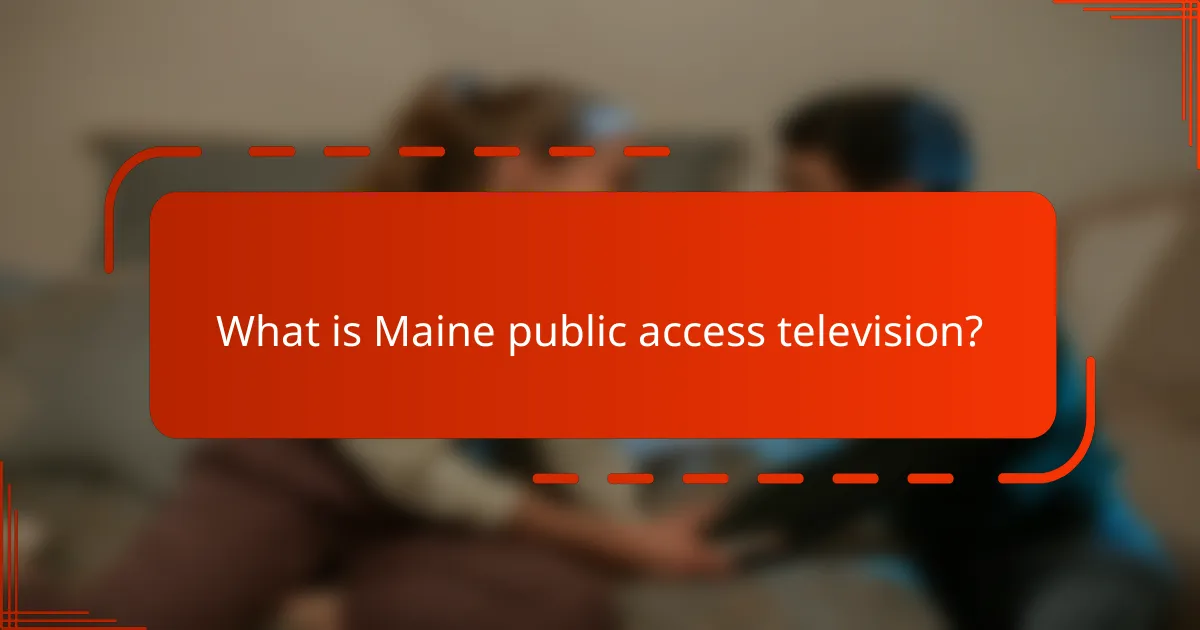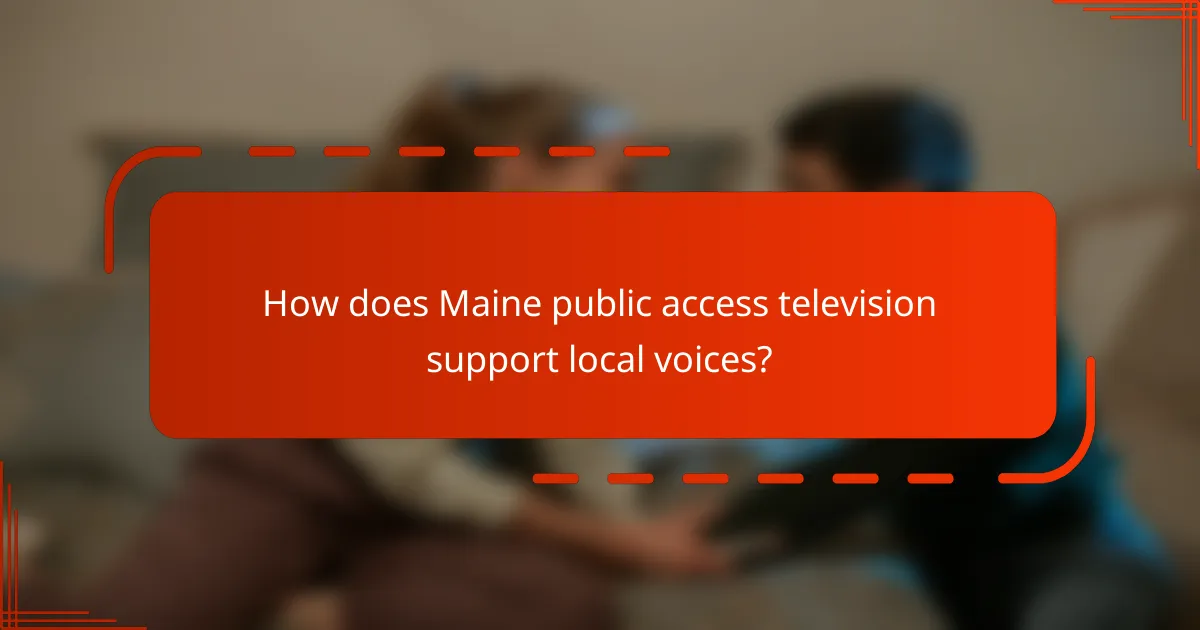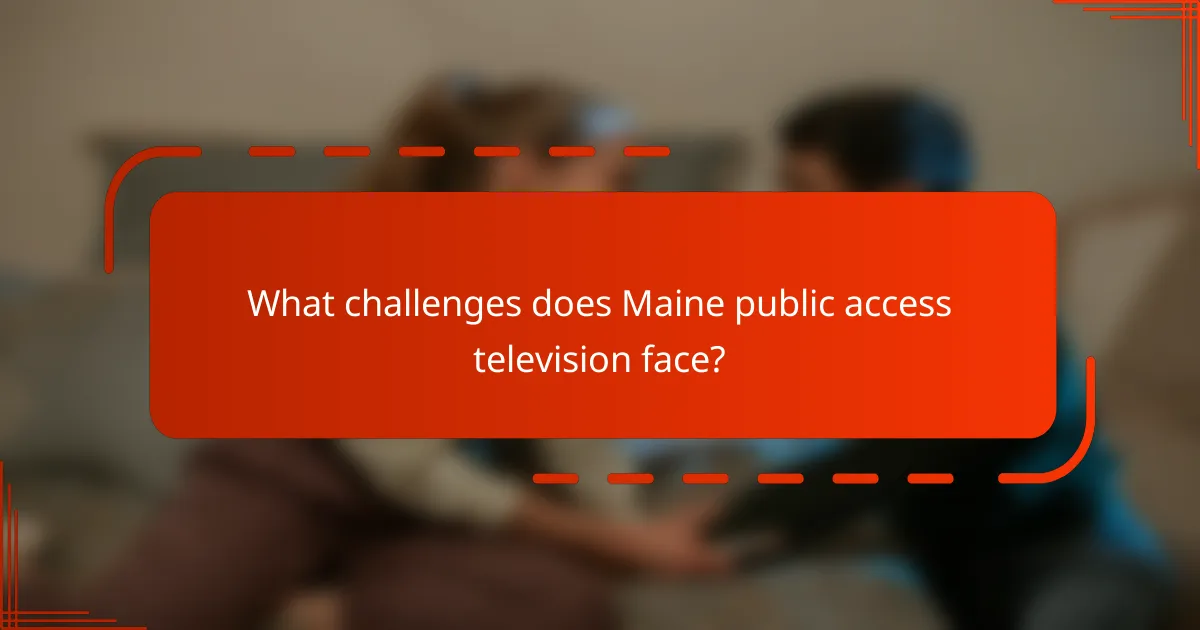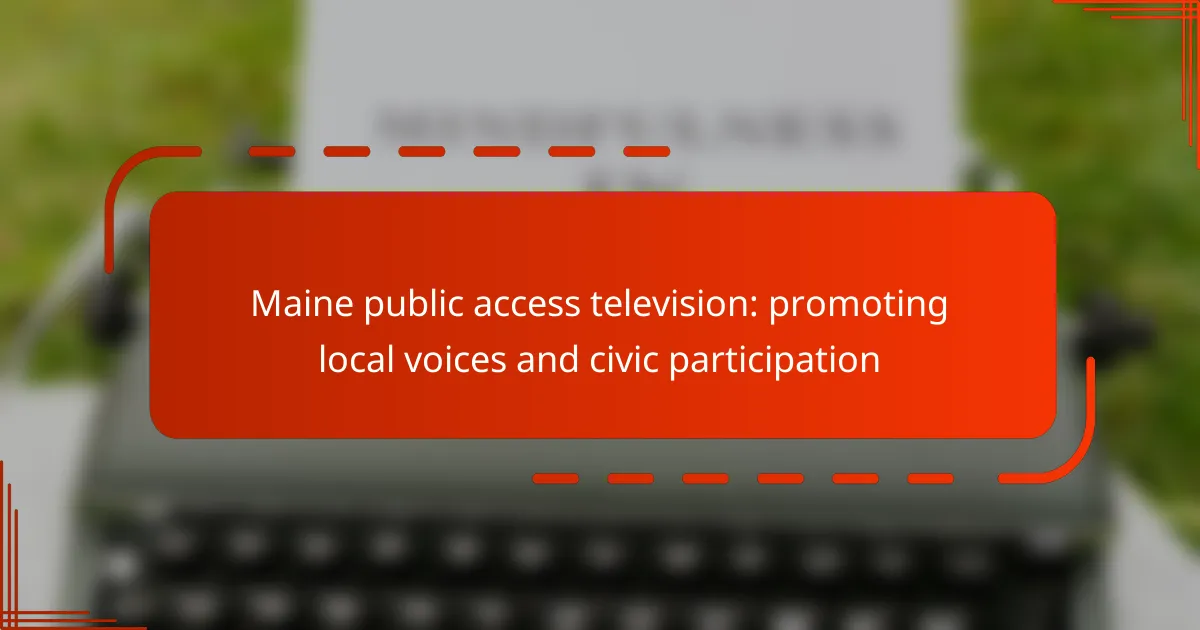Maine public access television is a community-focused media platform that empowers residents to create and broadcast their own television programs, promoting local voices and civic engagement. This initiative is primarily volunteer-driven, reflecting the interests and concerns of the community while providing access to broadcasting equipment and training. Maine’s public access channels facilitate dialogue among diverse groups, amplify underrepresented voices, and educate the public on local issues and events. However, these channels face challenges such as funding limitations, technological advancements, and competition from online platforms, which can impact programming quality and community participation. Overall, Maine public access television plays a crucial role in fostering community identity and encouraging democratic involvement.

What is Maine public access television?
Maine public access television is a community-based media platform that allows residents to create and broadcast their own television programs. It serves as a tool for promoting local voices and civic engagement. The programming is produced by volunteers and often reflects the interests and concerns of the community. Public access channels are typically funded through cable franchise fees. In Maine, these channels provide a space for diverse viewpoints and grassroots initiatives. They also help to educate the public about local issues and events. Maine public access television fosters a sense of community and encourages participation in the democratic process.
How does Maine public access television function?
Maine public access television functions by providing a platform for local residents to create and broadcast their own programming. This service is facilitated through community access channels available on local cable systems. Residents can produce shows that reflect community interests, enhancing local voices in media. Access centers offer training and resources to assist individuals in content creation. Programming can include everything from local news to arts and culture. Public access television is governed by the Federal Communications Commission regulations. This ensures that community members have the right to access and utilize these channels. The presence of public access television fosters civic participation and engagement within Maine communities.
What are the key components of Maine public access television?
Key components of Maine public access television include community programming, local content creation, and public participation. Community programming allows residents to produce and share their own shows. Local content creation fosters storytelling that reflects the unique culture and issues of Maine. Public participation encourages citizens to engage with media and express their views. These components support civic engagement and provide a platform for local voices. Public access channels in Maine serve as vital resources for information and community connection.
How do these components contribute to local broadcasting?
The components of Maine public access television enhance local broadcasting by facilitating community engagement. They provide a platform for residents to express their views and share local stories. Access to equipment and training empowers individuals to create their own content. This democratizes media production, allowing diverse voices to be heard. Local broadcasting becomes a reflection of community interests and issues. Furthermore, these components foster civic participation by encouraging dialogue on local governance and events. Studies show that public access channels increase community involvement and awareness. Thus, these components play a crucial role in strengthening local broadcasting.
Why is Maine public access television important for local communities?
Maine public access television is important for local communities because it provides a platform for diverse voices and local issues. It enables residents to share their stories and perspectives. This medium fosters civic engagement and participation. Local programming highlights community events, concerns, and achievements. According to the Maine Public Access Network, these channels enhance local democracy. They empower citizens to express themselves and connect with their neighbors. Public access television also serves as a resource for education and information. It strengthens community ties and promotes a sense of belonging.
How does it promote civic engagement?
Maine public access television promotes civic engagement by providing a platform for local voices. It allows community members to create and share content that reflects their interests and concerns. This accessibility fosters dialogue among residents. It encourages participation in local governance and community events. Viewers can engage with issues that matter to them. Public access programming often includes town meetings and discussions with local leaders. This transparency helps build trust between citizens and their government. Statistics show that communities with active public access channels report higher civic involvement.
What role does it play in giving a voice to local issues?
Maine public access television plays a crucial role in giving a voice to local issues. It provides a platform for community members to express their concerns and share their stories. This medium allows residents to engage in discussions about local governance and community needs. Programs often feature local leaders, activists, and citizens discussing pertinent issues. Access television fosters civic participation by encouraging viewers to get involved in their communities. Research indicates that public access channels enhance democratic engagement by increasing visibility for local voices. This involvement can lead to more informed decision-making at the local level.

How does Maine public access television support local voices?
Maine public access television supports local voices by providing a platform for community members to share their stories and perspectives. It offers access to broadcasting equipment and training for residents. This enables individuals to create and air their own content. The channels focus on local issues, events, and culture, fostering community engagement. Public access television also encourages dialogue among diverse groups. This helps amplify underrepresented voices in the media landscape. By prioritizing local content, Maine public access television strengthens community identity and participation.
What types of programs are featured on Maine public access television?
Maine public access television features a variety of programs that promote local voices. These programs include community events, educational content, and public forums. Additionally, local artists and musicians often showcase their work. Government meetings and local news segments are also common. Many programs are produced by residents, reflecting diverse perspectives. This platform encourages civic participation and engagement within the community. Public access television in Maine is essential for fostering local dialogue and creativity.
How do these programs reflect community interests?
Maine public access television programs reflect community interests by showcasing local issues and events. They provide a platform for residents to express their views and share their stories. Programs often feature community leaders, local artists, and activists. This representation fosters a sense of belonging and civic engagement. Viewers can learn about local governance, cultural events, and social initiatives. According to the Maine Public Access Association, these programs enhance public discourse and strengthen community ties. They also encourage participation in local decision-making processes. Overall, these programs serve as a vital link between citizens and their community.
What are some examples of successful local shows?
Successful local shows in Maine public access television include “Maine Cabin Masters,” which showcases home renovation and restoration projects. Another example is “207,” a news magazine that highlights local stories and events. “The Maine Experience” features cultural and historical segments about the state. “Maine’s Greatest Generation” honors veterans and their contributions. Each of these shows has garnered a dedicated viewer base, reflecting the community’s interests and values.
In what ways can residents participate in Maine public access television?
Residents can participate in Maine public access television by creating their own programs. They can utilize community access studios to produce content. Training sessions are often available to teach residents about video production. Residents can also volunteer to help with existing shows. Additionally, they can attend public meetings to voice their ideas. Some stations offer opportunities for internships to gain hands-on experience. Engaging with local programming can foster community dialogue. Maine public access encourages diverse voices and perspectives through these participatory avenues.
How can individuals create their own content?
Individuals can create their own content by utilizing public access television resources. They can access local studios and equipment for filming. Training sessions are often available to teach technical skills. Content can include community events, interviews, and educational programs. Individuals should develop a clear concept and script for their content. They can then record, edit, and submit their work for airing. Public access channels often encourage diverse voices and perspectives. This fosters civic participation and engagement within the community.
What resources are available for aspiring producers?
Aspiring producers can access various resources through Maine public access television. These resources include training workshops for technical skills and content creation. Equipment rental services are also available for producing high-quality video content. Producers can utilize studio facilities for filming and editing. Additionally, mentorship programs connect newcomers with experienced producers. Online tutorials and community forums provide further support and guidance. Local grants may be available to fund production projects. These resources collectively enhance the ability of aspiring producers to create engaging content.

What challenges does Maine public access television face?
Maine public access television faces several challenges. Funding limitations significantly impact programming quality and availability. Many stations rely on local government support and grants, which can fluctuate annually. Additionally, technological advancements pose challenges for content delivery and production. Some public access channels struggle to keep up with digital trends and viewer expectations. Training volunteers to produce quality content also remains a hurdle. Limited resources often lead to fewer training opportunities for community members. Lastly, competition from online platforms can detract from viewership and community engagement.
How do funding and resources impact local programming?
Funding and resources significantly impact local programming by determining the quality and quantity of content produced. Adequate funding allows for better equipment, skilled personnel, and diverse programming options. For instance, public access channels in Maine rely on grants and community support to maintain operations. This financial backing enables them to offer training programs for local creators. In turn, this fosters civic engagement and promotes local voices. According to the Alliance for Community Media, access to resources enhances community participation in media creation. Thus, funding and resources directly influence the effectiveness and reach of local programming initiatives.
What are common funding sources for public access channels?
Common funding sources for public access channels include government grants, viewer donations, and sponsorships from local businesses. Government grants often come from local or state agencies supporting community media. Viewer donations are critical, as they provide direct financial support from the audience. Sponsorships can help cover operational costs by partnering with local businesses interested in community engagement. Additionally, some channels receive funding from cable franchise fees, which are collected from cable providers. These fees are typically allocated to support local public access programming.
How can communities advocate for better support?
Communities can advocate for better support by organizing local forums and discussions. These gatherings allow residents to voice their needs and concerns. Engaging with local government officials is crucial. Communities can present data on the benefits of public access television. This includes statistics on increased civic participation and community engagement. Collaborating with local organizations amplifies their message. Partnerships can enhance outreach and resources. Utilizing social media platforms can raise awareness and mobilize support. Communities should also create petitions to demonstrate collective demand for better resources.
What technological advancements are influencing Maine public access television?
Maine public access television is influenced by advancements in digital broadcasting technology. The transition from analog to digital has improved picture and sound quality. High-definition (HD) broadcasting allows for clearer images, enhancing viewer experience. Streaming services have emerged, enabling on-demand access to local programming. Social media platforms facilitate broader audience engagement and interaction. Mobile technology allows viewers to access content on various devices. Cloud-based editing and storage solutions streamline content creation and distribution. These advancements foster greater community involvement and participation in local media.
How is digital media changing local broadcasting?
Digital media is transforming local broadcasting by enhancing accessibility and engagement. It allows local broadcasters to reach wider audiences through online platforms. Viewers can access content on-demand, leading to increased flexibility. Social media integration enables real-time interaction between broadcasters and the community. This fosters a sense of local involvement and participation. According to a 2021 Pew Research study, 53% of Americans consume news via social media. Additionally, digital tools facilitate the production of diverse content, reflecting local issues and voices more accurately. Local broadcasting now competes with global content, necessitating innovation and adaptation.
What tools are available for content creation and distribution?
Content creation and distribution tools include video editing software, graphic design platforms, and social media management tools. Video editing software like Adobe Premiere Pro and Final Cut Pro allows users to create professional-quality videos. Graphic design platforms such as Canva enable users to create engaging visuals easily. Social media management tools like Hootsuite and Buffer help schedule and distribute content across various platforms. These tools enhance the ability to produce and share content effectively.
What best practices can enhance participation in Maine public access television?
Engaging the community through outreach initiatives enhances participation in Maine public access television. Hosting workshops can educate residents about production techniques. Collaborating with local schools encourages student involvement. Providing accessible training resources empowers diverse voices. Promoting local content through social media increases visibility. Partnering with community organizations fosters a sense of ownership. Regularly showcasing local stories builds viewer interest. These practices have been shown to increase viewer engagement and participation rates in public access programming.
How can communities effectively promote their shows?
Communities can effectively promote their shows through targeted marketing strategies. Utilizing social media platforms increases visibility and engagement. Creating event pages on Facebook can attract local audiences. Collaborating with local businesses for cross-promotion enhances reach. Distributing flyers in community centers raises awareness. Engaging with local media for coverage can generate interest. Hosting preview events allows potential viewers to experience the content. According to a study by the Pew Research Center, 69% of adults use social media, highlighting its effectiveness for promotion.
What strategies can improve viewer engagement?
Strategies that can improve viewer engagement include interactive content, community involvement, and consistent communication. Interactive content encourages viewers to participate through polls, Q&A sessions, or live discussions. Community involvement fosters a sense of belonging. Collaborating with local organizations can increase viewership and participation. Consistent communication through newsletters and social media keeps the audience informed and engaged. Data shows that channels with active viewer interaction see a 30% increase in engagement. Engaging storytelling also captivates audiences, making them more likely to tune in regularly.
Maine public access television is a community-based media platform that empowers residents to create and broadcast their own programs, promoting local voices and civic engagement. The article outlines how this platform functions, its key components, and its importance in fostering community dialogue and participation. It highlights the diverse programming available, the resources for aspiring producers, and the challenges faced, including funding and technological advancements. Additionally, it discusses strategies for enhancing viewer engagement and community advocacy for better support, emphasizing the role of public access television in strengthening local democracy and representation.
